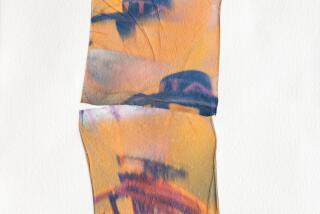A Gingerbread City in a Modern World
- Share via
SAN'A, Yemen — Taken one at a time, the elements of traditional San’a architecture couldn’t be more rational: geometric shapes in stark white; fine decorative motifs balanced by heavy stone blocks; arched windows suggesting the unity of the circle.
But taken together, these same elements are downright playful. San’a resembles nothing so much as a giant gingerbread city, its warm brown stones and bricks iced with plaster.
San’a has inspired passionate campaigns to preserve and record one of the world’s most beautiful cities.
“It’s like living inside a masterpiece--something done with the hands,” says Marco Livadiotti, who lives in a 120-year-old house in San’a and runs a travel agency out of one of the Yemeni capital’s 18th-century palaces.
“Yemeni architecture is unique. It’s something between architecture and sculpture.”
The Italian-born Livadiotti, who has lived in Yemen for 40 years, renovated his own home and office and has undertaken similar projects for embassies and hotels. Along the way he has earned a reputation as an expert on Yemeni architecture.
UNESCO, the United Nations cultural organization, declared San’a a World Heritage Site in 1988. Preservationist Ronald Lewcock, writing for UNESCO, compared San’a to Venice: “Its value lies not so much in the merit of the individual buildings, important though they may be, as in the unforgettable impression made by the whole--an entire city of splendid buildings combining to create an urban effect of extraordinary fascination and beauty.”
Yemen artist Mazher Nizar says no city compares to his San’a.
“There’s fantastic composition possibilities for watercolor,” Nizar says. “There is a real subject--details, light and shadow, the brickwork. As an artist, I cannot ignore it.”
Nizar is famous in Yemen for his annual shows of watercolor or pen-and-ink street scenes of walled Old San’a.
San’a was a trade capital as early as the 1st century before Christ. Its prosperous merchants huddled inside the mud walls of the city in an area small enough for a modern tourist to explore on foot in a few hours. Starved for space, San’anis built up--as high as nine stories.
San’a’s “tower houses” rest on lower stories built of stone; some of those still standing date to the 9th or 10th centuries. Over the generations, families added floors in brick to the basic stone structure. For stability, each new floor was slightly smaller than the previous one.
The houses grew almost organically, according to no plan, Livadiotti says. And living among the resulting uneven stairs and oddly shaped rooms can take some getting used to.
“It’s like when you buy a piece of material that is handmade,” he suggests. “It will never be perfect, but it’s beautiful.”
Residents of the wealthy economic and later government capital could afford decorative flourishes. San’anis expressed themselves in bright, white plaster mixed from gypsum, running bands of interlocked chains, braids, undulating waves where each new floor joined the old structure. More plaster friezes run along the roof lines.
Windows are also outlined in thick plaster lines, as if applied with giant pastry cones. Each window is typically topped with an arched, stained-glass window in floral patterns outlined with more plaster.
In the oldest houses, the arches were of alabaster. In a few houses still standing, alabaster windows continue to cast a golden glow into rooms plastered in stark white gypsum.
Turkish Influence
Was a Two-Way Street
Stained glass was an innovation brought by the Turks, who captured San’a in 1547. The Turks seem to have adopted even more from the Yemenis, judging from the city they built themselves just west of the walls of Old San’a. The Turkish houses and palaces were built of local materials--handmade bricks and hand-cut stone--and lavishly decorated with plaster in the Yemeni style.
Modern architects, like the Turks, can’t seem to shake off the influence of traditional San’a style. The antenna platform at the downtown headquarters of the state telecommunications company looks like an oversized tower house.
Even the starkest shoe box of an office building in today’s San’a has stained-glass, arched windows. But the glass these days is set in cookie-cutter concrete forms instead of handmade plaster.
UNESCO and the Yemeni government helped organize a major preservation and conservation campaign for San’a in the early 1980s. Since then, individuals have saved other buildings to use as hotels, cultural centers and homes. The Dutch and other governments are now in the midst of renovating a fort dating to the early Islamic period that is home to the National Museum.
But preservationist Livadiotti worries that Yemenis are keeping only a few symbols of their traditions.
Livadiotti was 5 when his father, a doctor, brought him to Yemen. His father cared for Yemen’s last imam, who had wielded political and religious power. Livadiotti says that as late as 1960, the imam’s car was the only one in San’a. But in 40 short years, San’a has become modern and traffic-clogged. Like many developing cities, there seems to be little time or money to spare for preserving the past.
From the roof of his office, Livadiotti sees signs of what he fears will be the future.
Across the street, a new concrete office building is being built on the site of an old palace. It took just a day to tear down a mud-brick palace that Livadiotti would rather have seen renovated.
In his own palace, stained-glass windows cast their jeweled light on a computer and a sleek Italian lamp on his desk.
“People can live in a modern way and they can live with tradition,” he says.
More to Read
Sign up for The Wild
We’ll help you find the best places to hike, bike and run, as well as the perfect silent spots for meditation and yoga.
You may occasionally receive promotional content from the Los Angeles Times.






